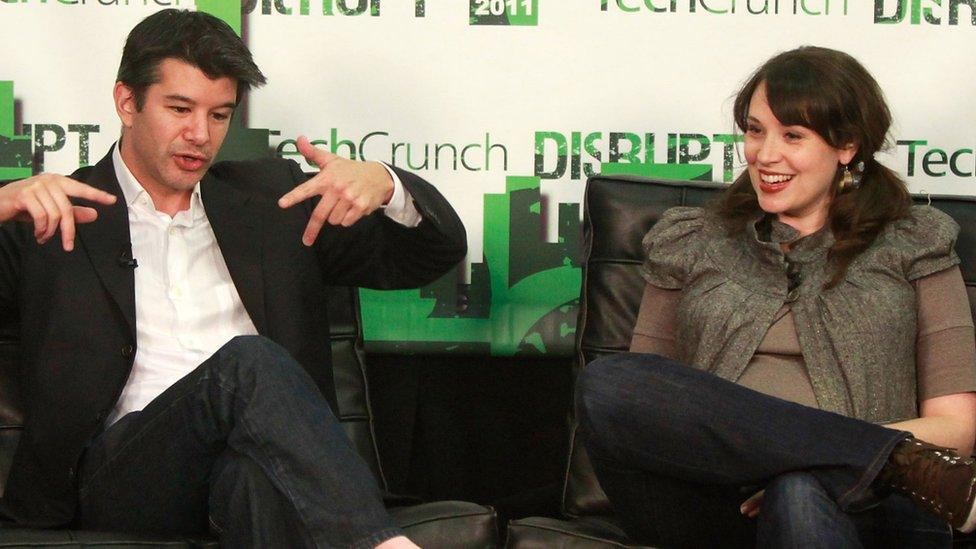Tech Tent: Uber at a crossroads
- Published

Stream or download, external the latest Tech Tent podcast
Listen to previous episodes on the BBC website
Listen live every Friday at 15:00 GMT on the BBC World Service
On the Tech Tent podcast this week, we explore the stunning resignation of Uber chief executive Travis Kalanick. We also hear why Indian IT workers are suffering mass lay-offs - and we ask whether virtual reality could have a more serious purpose beyond games and entertainment.
Uber loses its head
After last week's news that Uber founder and chief executive Travis Kalanick was taking a leave of absence from the company, some observers might have assumed that would be the end of the turmoil for Uber's management - at least for now.
But this week the company announced Mr Kalanick was stepping down from his role altogether - though he will remain on the company's board.
The move came after a series of scandals over the the way Uber bosses treated female employees and customers.
Matters came to a head recently when a female ex-employee wrote a blog post detailing how managers failed to act on her complaints about sexism at work. That resulted in an investigation by the former US Attorney General Eric Holder, which recommended ways in which the company could change its culture and be run better.

On the podcast, we speak to Silicon Valley tech journalist Sarah Lacy, who, with her team, was among the first to report on Uber's attitudes to women. She says it is the first time in three years that she can wake up without worrying whether she or her family will face some sort of retaliation from Uber.
But she says it may be ambitious to think Uber can change its culture unless it hires a totally different type of senior manager.
"It is hard to believe there is going to be a huge cultural reset here, and it is hard to believe that a company that is entirely staffed by people hired under that regime are suddenly going to do a big cultural re-shift," she says.
India's IT workers out of work
In recent years, India's IT sector has been a poster-child for the country's rapid economic growth. By providing outsourced IT services to brands across the world, the multibillion dollar industry helped create millions of jobs for Indians.
But the industry is now facing a slowdown because of a trend by Western companies to bring some IT jobs home, and the inroads being made by automation. Some of the jobs that used to be done by Indian workers can now be handled by software. These changes have led to drastic cuts, and there are fears there could more layoffs in the coming months and years.
The BBC's Sameer Hashmi travelled to Bangalore - regarded as India's Silicon Valley - to meet workers and managers.
He met 49-year old Pankaj Rao, who, after working in a prestigious IT job for a decade, was dismissed along with his entire team. He is now frantically sending his resume to prospective employers.
"My father, my wife, my children, all are worried what will happen tomorrow," he says.
But Atul Kanwar, the chief technology officer at the IT giant Tech Mahindra, says it's likely that all jobs that involve repetitive tasks will be automated.
"Automation is all-pervasive," he says. "It used to be a situation of doing it at the lowest end but now automation is for any repetitive task." He advises workers: "Make sure that over time you are not doing a repetitive task."
A virtual trip to space
So far, the focus for virtual reality has been on games and entertainment. But could its so-called "killer application" be in the workplace, for training staff, for example?
Zoe Kleinman visited the IBM research labs in Hursley, Hampshire, where she tried out a VR simulation.
From inside an English country house she paid a virtual visit to the International Space Station, where she floated around and even popped out through a hatch into Space to explore outside the craft.
Gwillam Newton, emerging-tech specialist at IBM, tells Zoe how the company is pitching the technology as a way for companies, such as airlines, to train aircrew without leaving the ground.
"Places where it's hard to go and train people or are expensive, the idea is that you create a few virtual reality rigs like this, and people can explore virtual reality in a safe and cost-effective manner."
- Published21 June 2017
